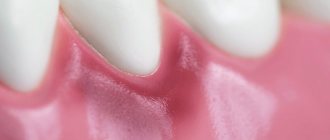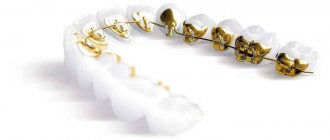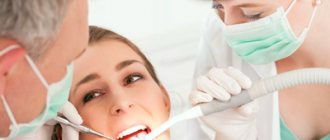Erosion of tooth enamel is a serious dental disease of a non-carious nature, manifested in the gradual abrasion of dental tissue. The disease can appear not only in adults, but also in children, although baby teeth are affected much less frequently. The difficulty in treating erosion lies in the fact that people suffering from erosive lesions of the teeth perceive it solely as an external defect, and are in no hurry to go to the dental office. Features of the disease, methods of its diagnosis, treatment and prevention will be discussed in detail in this article.
Stages and features of treatment of tooth enamel erosion
Treatment of this disease is a rather long and complex process, the success of which often depends on the stage of its development. Based on this, appropriate treatment methods are selected.
Based on the intensity and depth of the lesion, the following stages of the disease are distinguished:
- Initial. Not visually detectable. The top layer is affected.
- Average. The disease becomes visually noticeable, there is a pronounced whitish tint, and all layers of enamel are susceptible to destruction.
- Heavy. The entire enamel is affected, the upper layer of dentin is involved.
It is important to understand that this pathology does not appear immediately, but gradually destroys the enamel and leads to serious consequences.
The disease can be identified by a number of symptoms:
- loss of the original shine of the enamel;
- change in tooth color;
- tooth sensitivity, pain when exposed to hot/cold food. This is explained by the appearance of a cavity in the affected area, which reacts to thermal changes and causes a corresponding painful reaction;
- the contours of the teeth are unnaturally transparent in appearance.
If such symptoms occur, you should make an appointment with the dentist.
What causes erosion?
The disease is associated with factors that regularly injure the enamel:
- mechanical damage due to too “aggressive”, active brushing of teeth, frequent use of abrasive paste or a hard brush, the habit of gnawing hard objects, improper distribution of the chewing load due to malocclusion;
- effects of acids: frequent consumption of citrus fruits, acidic foods or drinks, or problems with the gastrointestinal tract (regurgitation of gastric juice due to heartburn, eating disorders);
- endocrine diseases, metabolic problems, due to which the content of magnesium and ionized calcium in the blood decreases. The appearance of enamel erosion due to this reason requires mandatory examination: it may indicate a high risk of developing osteoporosis and other serious diseases;
- age-related changes in the structure of hard tissues, due to which they become weakened and more susceptible to aggressive action.
Enamel erosion develops quickly. At the initial stage it is difficult to notice, it manifests itself as a slight loss of gloss, but in general the structure of hard tissues remains unchanged, only the top layer of enamel is damaged. When the entire thickness of the enamel layer is damaged, erosion becomes noticeable, the stain deepens, and may darken. Without treatment, destruction reaches the dentinal layer. As erosion develops, the enamel becomes highly sensitive. If the incisors are affected, in some cases their edges may become transparent.
You have questions?
We will call you back within 30 seconds
+7
The defect most often occurs on premolars, canines, incisors, can affect symmetrically located teeth, and mainly affects the anterior surface of the crown.
Factors and stages of disease development
In fact, there are quite a few reasons that provoke enamel erosion.
However, it is possible to identify the main factors that affect the condition of teeth:
- disorders of the thyroid gland;
- abuse of foods with high acidity;
- uneven distribution of load during chewing (for example, chewing on one side / missing several teeth)
- teeth grinding (so-called bruxism);
- somatic diseases of the internal organs of the digestive tract (gastritis, toxicosis during pregnancy, bulimia causes a change in the composition of saliva, increasing its acidity);
- improperly formed bite;
- use of medications (antibiotics, hormonal, antiviral drugs, medicines, etc.);
- mechanical injuries, chips that violate the integrity of the enamel;
- use of low quality toothpastes, tooth powder or frequent use of whitening agents;
- working in production and being in an environment with harmful working conditions (inhalation of chemicals and dust by mouth);
- ecological situation.
Enamel erosion is most often detected in people who do not carefully observe the rules of personal oral hygiene. To avoid the development of this disease, it is recommended to visit a dental hygienist (2 times a year), who will perform comprehensive professional teeth cleaning.
Causes of pathology
Erosion of the front teeth does not occur out of nowhere. Doctors identify several groups of reasons why this disease develops.
| Group of reasons | Risk factors |
| Chemical or acidic |
|
| Mechanical |
|
| Endocrine | Erosion of primary or permanent teeth is typical for patients who have metabolic disorders and hormonal imbalances. It can occur due to hyperfunction (increased production of hormones) of the thyroid gland |
Tooth erosion is a disease that can have multiple causes. The problem often arises against the background of several risk factors at once.
“My problem arose while visiting the pool every day, because I was a professional swimmer for many years. As the doctors said, all this is due to the fact that a lot of chlorine is added to the water, and this has caused the teeth to deteriorate...”
Camilla, review from yell.ru
Diagnostics
This disease can be diagnosed during a dental examination. The dentist detects the location of the erosive focus by thoroughly drying the tooth surface with a stream of air and lubricating it with 5% iodine tincture. The area of enamel affected by the disease becomes brownish in color.
Erosion differs from other pathological processes in its contours, localization, smooth surface and is usually located closer to the base of the root.
The earlier the pathology is diagnosed, the more successful its treatment will be.
Symptoms of tooth erosion
At the superficial stage of development of the disease, it is quite difficult to notice changes with the naked eye. The enamel loses its natural shine, but this is not very noticeable to others. Erosion can be detected at this stage only if the surface of the tooth is thoroughly dried and then an iodine infusion is applied. Those places where the enamel is damaged by erosion will turn yellow-brown. This stage of the disease occurs without pain, which often becomes the reason that the patient does not notice changes in time and does not seek medical help.
With moderate severity of erosion, the erosive defect looks like a whitish cup-shaped spot. With deep erosion, the erosive defect has a yellow or brown color.
Erosion of enamel is accompanied not only by its destruction, but also by abrasion of hard tooth tissues, as well as other destructive processes. In the deep stage of dental erosion, the patient may experience symptoms of dental hypersensitivity or pain. Such unpleasant sensations intensify many times over with thermal, mechanical or any other effect on the teeth.
Therapeutic measures
Treatment of erosion consists of a combination of the following methods:
- Remineralizing. A set of measures that includes applying a drug with a high calcium content to the lesions. Usually 3-5 procedures are prescribed. To consolidate the positive effect, fluoride varnish is applied to the damaged surface.
- Physiotherapeutic treatment. Calcium electrophoresis, which promotes the restoration of tooth tissue.
- Restoration. In case of severe tooth damage, the dentist recommends the use of veneers and crowns to hide the cosmetic defect and protect the tooth from further destruction.
- General therapy. Medications, vitamin therapy, and enrichment of the body with essential microelements are prescribed.
- Tooth polishing and whitening. Polishing is carried out using a special paste or powder, and bleaching and covering the eroded areas with fluorine-containing varnish will help restore the former whiteness.
Visible changes indicate the effectiveness of the treatment. The lesions begin to lighten and decrease in size.
Treatment procedure
In case of erosion, the dentist has two tasks: to restore hard tissues and to prevent their re-destruction. The doctor examines the patient and determines what caused the defect. If the problem is in the choice of toothbrush and toothpaste, they are replaced with less “aggressive” ones. The dentist may recommend changing your diet (eating less acidic, sweet foods, drinks), and being examined by a gastroenterologist or endocrinologist.
When restoring teeth, the doctor removes the affected tissue, cleans the cavity and recess (if they are already formed). In case of advanced erosion, restoration with a dental composite, installation of veneers or prosthetics with artificial crowns are performed. If the destruction does not extend beyond the enamel layer, treatment is carried out by remineralization, fluoridation, and coating with a protective varnish.
Prevention
To prevent the formation of erosive lesions, the following preventive measures must be taken:
- reduce consumption of foods/drinks containing large amounts of acids;
- brush your teeth with a paste enriched with fluoride and calcium;
- avoid drinking too hot/cold drinks;
- After each meal, normalize the acid balance, or use sugar-free chewing gum;
- follow the rules for brushing your teeth: start from the back surface, spend at least 2 minutes brushing your teeth, and do not put too much pressure on the brush;
- When purchasing, give preference to brushes that have medium-hard bristles;
- if it is not possible to brush your teeth after each meal, then it is advisable to rinse your mouth with water at room temperature;
- drink acidic drinks through a straw;
- after a diet that consisted of acid-containing foods, it is better to refrain from brushing your teeth for one to two hours;
- For preventive purposes, visit the dentist’s office once every six months.
Following these simple rules will help reduce the risk of developing such an insidious disease as tooth enamel erosion.
Diet features
For example, when following a vegetarian or raw food diet, fruit becomes a very large component of the diet. Of course, fruits and the vitamins they contain are beneficial in themselves; but acids that attack tooth enamel when eating fruits (mainly citrus fruits) can cause erosion.
This circumstance is also relevant for drinking juices.
Excessive consumption of carbonated drinks can also negatively affect the condition of tooth enamel and lead to erosion.
Where can you find a qualified dentist in Ivanteevka?
High-quality dental care is provided by specialists from the Sanident clinic. We are one of the largest clinics providing our services in Shchelkovo and in the urban district of Ivanteevka. We have the most modern equipment, employ only professionals with extensive experience, who use progressive methods of dental treatment and provide competent advice. We regularly hold various promotions and discounts for our patients.
The activities of our clinic are aimed at creating maximum comfort for our patients, minimizing pain and discomfort. You can make an appointment with a specialist by calling the number listed on the official website of dentistry.
You can receive the necessary dental services at the following addresses:
- Ivanteevka, st. Novoselki, 4;
- Shchelkovo, st. Central, no. 80.
Dangerous consequences if the disease is not treated
In the absence of timely measures, the destructive process goes wider and deeper into the crown, and hard tissues react with acute pain to any impact, quickly wear out and wear down, become fragile, and can break off and chip. Weakened enamel becomes susceptible to caries and its complications - pulpitis and periodontitis, which develop rapidly. Among other things, the aesthetics of a smile is disrupted, which is why a person begins to feel complex.
“Patients often consider enamel erosion to be just an aesthetic defect, although in fact it is a serious dental disease that can progress and recur. Pathology can cause complete destruction and loss of a tooth,” says O.B. Krivtsov, a dentist with 15 years of experience.
Treatments you can take at home
People who have dental erosion often wonder if they can undergo treatment at home. All the patient can do at home is to help strengthen hard tissues. For example, using fluoride varnish, but its independent use can be hazardous to health. Why? Read the feature article on the website.
At home, you can perform remotherapy, use strengthening pastes (for example, ROCS Medical Minerals, Tooth Mousse), and take vitamins orally. You should purchase medications only after consultation with a dentist, who will accurately diagnose and select the most effective remedies.









